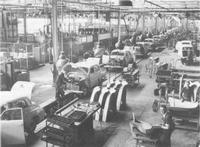


Chapter 7
I The First 100 Years 1788-1888
II Railways
III Motorised Vehicles
i Trucks
ii Truck Manufacturing
iii Road Trains
iv The Diesel Electric Ore Trucks
v Buses and Coaches
IV Aviation
V Modern Shipping
VI Innovative Small Craft
VII Conclusion
VIII Acknowledgements
IX Contributors
References
Index
Search
Help
Contact us

One aspect of motor car evolution has been the frequent upgrading, new models, introduction of improved technology and perhaps the most insidious, the marketing demand for the annual styling change. Faced with the adverse economies of scale, attempting to maintain synchronised model production with overseas, created immense problems of cost and practicality as local content requirements increased. These factors, in part, were influential in convincing the automobile manufacturers that there would be merit in a local design with greater model longevity and maximum part interchangeability between models.
Rapid expansion of demand for motor vehicles after the First World War was, in part, a result of the recognition of the flexibility of road transport compared to rail, and as better roads were constructed and vehicle reliability improved, more and more people were attracted to purchase a car. Having established the demand, it became necessary to assist people financially to purchase motor cars and there is no doubt that the availability of hire purchase facilities as a marketing support was a major factor in 'putting the nation on wheels'.
The Second World War, with the curtailment of imports, forced the transport industry to maintain its fleets by local part production or adaption and, together with essential defence demands, led to the development of expanded engineering capacity. Vehicle manufacturers were mobilised to produce a variety of defence needs, ranging from sea mines, landing craft, aircraft auxiliary fuel tanks, and reconditioned aero engines, to armoured fighting vehicles. Components were manufactured for Gypsy Moth aero engines, to Beaufort and Beaufighter aircraft and a variety of guns from the 6 pounder and 2 pounder anti tank guns and 20 mm anti aircraft gun to 25 pound howitzers, all apart from the many thousands of army trucks of all kinds produced by several companies. These defence requirements not only made an impact upon the motor car manufacturer but, importantly, involved the whole supplier industry and, through the necessity of wartime, exposed people to the production of components normally imported, and in many cases established skills quite foreign to the company prior to the commencement of hostilities.
Due to the shortage of petrol in the country during the 1939-45 war, civilian consumption of fuel was strictly rationed and only sufficient was provided for official duties. As a means of maintaining some of the more urgent transport links, gas producer units were developed to provide combustible gas by drawing air over hot wood coke under controlled conditions. Trucks, buses and cars were equipped with Australian designed and built gas producer units and a significant part of the national fleet of vehicles maintained schedules at great savings in conventional fuel.
Post war, the Australian Government saw opportunities for utilising the skills developed during the hostilities, which would at the same time provide employment to returning servicemen and new immigrants by encouraging vehicle manufacture. Motor companies were invited to submit plans for manufacture in Australia at a high level of local content (90 per cent) in return for tariff and quota protection.
General Motors Holden made a proposal which was accepted and the first 'Australian' Holden was manufactured in 1948. The volume projections for the G.M.H. Holden were such as to permit the first use of mass production techniques in Australia. Engine manufacture was based on dedicated continuous production lines and the foundry, chassis plant, stamping plant and assembly plants were technically advanced in selection of processes appropriate to the cost balance between mechanisation and manpower (Fig. 19).

Organisations in Australian Science at Work - General Motors Holden
 |
Australian Academy of Technological Sciences and Engineering |  |
© 1988 Print Edition pages 492 - 494, Online Edition 2000
Published by Australian Science and Technology Heritage Centre, using the Web Academic Resource Publisher
http://www.austehc.unimelb.edu.au/tia/485.html